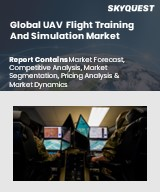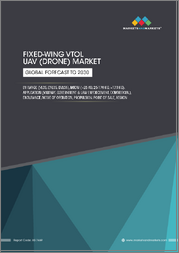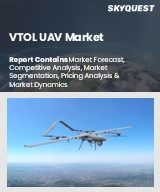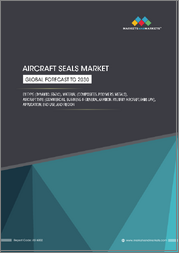
|
시장보고서
상품코드
1603413
UAV 비행 트레이닝 및 시뮬레이션 시장 규모, 점유율, 성장 분석 : 유형별, 용도별, 지역별 - 산업 예측(2024-2031년)UAV Flight Training and Simulation Market Size, Share, Growth Analysis, By Type (High Altitude Long Endurance (HALE) UAV, Medium Altitude Long Endurance (MALE) UAV), By Application, By Region - Industry Forecast 2024-2031 |
||||||
UAV 비행 트레이닝 및 시뮬레이션 세계 시장 규모는 2022년에 16억 달러를 기록했으며, 2023년 18억 달러에서 2031년에는 71억 달러로 성장하고, 예측기간(2024-2031년) 동안 CAGR은 18.1%로 성장할 전망입니다.
세계 UAV 비행 트레이닝 및 시뮬레이션 시장은 다양한 응용 분야에서 무인항공기(UAV) 채택이 증가함에 따라 강력한 성장세를 보이고 있습니다. 이러한 프로그램은 UAV 조종사가 실제 무인항공기를 운용하기 전에 UAV 조종사를 훈련시키는 데 필수적입니다. 주요 성장 촉진요인으로는 군사비 증가, UAV 기술 발전, 상업 분야에서의 드론 사용 확대 등이 있습니다. 자원 제약과 규제 문제가 잠재적인 성장 장벽으로 작용하는 반면, 시장에는 큰 기회가 있습니다. UAV 생태계가 진화함에 따라 맞춤형 솔루션은 운영의 복잡성을 해결하고 장기적인 시장 성장을 촉진하는 데 매우 중요한 역할을 할 수 있습니다. 장기적인 시장 확대를 촉진하는 데 있어 매우 중요한 역할을 할 것으로 보입니다.
목차
소개
- 조사 목적
- 조사 범위
- 정의
조사 방법
- 정보 조달
- 2차 데이터와 1차 데이터 방법
- 시장 규모 예측
- 시장 가정과 제한
주요 요약
- 세계 시장 전망
- 공급과 수요 동향 분석
- 부문별 기회 분석
시장 역학과 전망
- 시장 개요
- 시장 규모
- 시장 역학
- 성장 촉진요인과 기회
- 성장 억제요인과 과제
- Porters 분석과 영향
- 경쟁 기업 간의 경쟁 관계
- 대체품의 위협
- 구매자의 교섭력
- 신규 참여업체의 위협
- 공급 기업의 교섭력
주요 시장 인사이트
- 핵심성공요인
- 경쟁 정도
- 주요 투자 기회
- 시장 생태계
- 기술 분석
- 규제 분석
- 시장 매력 지수
- 가격 분석
UAV 비행 트레이닝 및 시뮬레이션 시장 규모 : 유형별 & CAGR(2024-2031)
- 시장 개요
- 고고도 장시간 체공(HALE) UAV
- 중고도 장시간 체공형(MALE) UAV
- 소형 무인항공기
UAV 비행 트레이닝 및 시뮬레이션 시장 규모 : 용도별 & CAGR(2024-2031)
- 시장 개요
- 민간 및 상업
- 방위·군
- 국토안보
UAV 비행 트레이닝 및 시뮬레이션 시장 규모 : 지역별 & CAGR(2024-2031)
- 북미
- 미국
- 캐나다
- 유럽
- 영국
- 독일
- 스페인
- 프랑스
- 이탈리아
- 기타 유럽
- 아시아태평양
- 중국
- 인도
- 일본
- 한국
- 기타 아시아태평양
- 라틴아메리카
- 브라질
- 기타 라틴아메리카
- 중동 및 아프리카
- GCC 국가
- 남아프리카공화국
- 기타 중동 및 아프리카
경쟁 정보
- 상위 5개사의 비교
- 주요 기업의 시장 포지셔닝(2023년)
- 주요 시장 기업이 채용한 전략
- 시장의 최근 동향
- 기업의 시장 점유율 분석(2023년)
- 주요 기업 개요
- 기업 개요
- 제품 포트폴리오 분석
- 부문별 점유율 분석
- 매출 전년비 비교(2021-2023)
주요 기업 개요
- CAE Inc.
- Israel Aerospace Industries(IAI) Ltd.
- L3Harris Technologies Inc.
- Simlat UAS Simulation
- General Atomics
- Northrop Grumman Corporation
- Textron Inc.
- Zen Technologies Limited
- Quantum3D
- H-SIM
- Presagis USA Inc.
- Selex ES
- Thales Training & Simulation
- BAE Systems
- Crew Training International Inc.
- Lockheed Martin Corporation
- Indra Sistemas
- Kratos Defense & Security Solutions
- Elbit Systems Ltd.
- Havelsan
결론과 추천사항
ksm 24.12.13Global UAV Flight Training and Simulation Market size was valued at USD 1.6 billion in 2022 and is poised to grow from USD 1.8 billion in 2023 to USD 7.1 billion by 2031, growing at a CAGR of 18.1% during the forecast period (2024-2031).
The global UAV Flight Training and Simulation Market is witnessing robust growth, driven by the rising adoption of unmanned aerial vehicles (UAVs) across diverse applications. These programs are essential for training UAV pilots prior to operating actual drones. Key growth drivers include increased military spending, advancements in UAV technology, and the expanding use of drones in commercial sectors. Despite resource constraints and regulatory challenges posing potential growth barriers, the market offers significant opportunities. Providers can leverage the demand for tailored training programs to cater to specific industry needs, enhancing their market presence and revenue potential. As the UAV ecosystem evolves, customized solutions will play a pivotal role in addressing operational complexities and driving long-term market expansion.
Top-down and bottom-up approaches were used to estimate and validate the size of the Global UAV Flight Training and Simulation market and to estimate the size of various other dependent submarkets. The research methodology used to estimate the market size includes the following details: The key players in the market were identified through secondary research, and their market shares in the respective regions were determined through primary and secondary research. This entire procedure includes the study of the annual and financial reports of the top market players and extensive interviews for key insights from industry leaders such as CEOs, VPs, directors, and marketing executives. All percentage shares split, and breakdowns were determined using secondary sources and verified through Primary sources. All possible parameters that affect the markets covered in this research study have been accounted for, viewed in extensive detail, verified through primary research, and analyzed to get the final quantitative and qualitative data.
Global UAV Flight Training and Simulation Market Segmental Analysis
Global UAV Flight Training and Simulation Market is segmented by Type, Application, and region. Based on Type, the market is segmented into High Altitude Long Endurance (HALE) UAV, Medium Altitude Long Endurance (MALE) UAV, Small Unmanned Aerial Vehicle. Based on Application, the market is segmented into Civil & Commercial, Defense & Military, and Homeland Security. Based on region, the market is segmented into North America, Europe, Asia Pacific, Latin America and Middle East & and Africa.
Drivers of the Global UAV Flight Training and Simulation Market
Our analysis reveals that the growing adoption of UAVs across diverse industry verticals, including military, commercial, and civil sectors, has significantly fueled market growth. These applications range from surveillance and defense to logistics, agriculture, and disaster management, demonstrating the broad utility of UAVs. This rising adoption has directly driven an increase in UAV sales, creating a pressing demand for skilled UAV pilots capable of operating these advanced systems efficiently. Consequently, this surge in UAV usage and sales has propelled the need for specialized UAV flight training and simulation solutions. These systems are essential for equipping operators with the expertise to handle UAVs in complex scenarios, ensuring safety and operational efficiency, thereby driving the global UAV flight training and simulation market.
Restraints in the Global UAV Flight Training and Simulation Market
The global UAV flight training and simulation market faces significant restraint due to the complex and fragmented nature of UAV regulations, which vary widely across regions and applications. Developers of UAV simulators encounter challenges in ensuring their systems align with diverse and ever-evolving compliance norms. This complexity is compounded by the dynamic regulatory landscape, where frequent updates and changes create uncertainty and operational hurdles. Adapting simulators to meet these shifting standards demands significant time, effort, and resources, making it difficult for companies to maintain consistent compliance. As a result, this regulatory uncertainty negatively impacts the demand outlook for UAV flight training and simulation solutions, posing a barrier to the market's growth and broader adoption.
Market Trends of the Global UAV Flight Training and Simulation Market
The global UAV flight training and simulation market is witnessing a notable trend toward highly customized training programs tailored for specific applications. Providers are focusing on offering bespoke solutions to eliminate unnecessary features, thereby reducing development costs and enhancing value for end-users. This approach enables market players to optimize operations by catering to the precise needs of target companies across diverse industries. Moreover, customization helps maximize revenue potential by aligning offerings with client-specific requirements, fostering long-term partnerships. This trend is expected to redefine market dynamics, as players increasingly prioritize scalability and efficiency through focused and application-specific simulation solutions, ensuring competitive advantages in a rapidly evolving UAV ecosystem.
Table of Contents
Introduction
- Objectives of the Study
- Scope of the Report
- Definitions
Research Methodology
- Information Procurement
- Secondary & Primary Data Methods
- Market Size Estimation
- Market Assumptions & Limitations
Executive Summary
- Global Market Outlook
- Supply & Demand Trend Analysis
- Segmental Opportunity Analysis
Market Dynamics & Outlook
- Market Overview
- Market Size
- Market Dynamics
- Driver & Opportunities
- Restraints & Challenges
- Porters Analysis & Impact
- Competitive rivalry
- Threat of substitute
- Bargaining power of buyers
- Threat of new entrants
- Bargaining power of suppliers
Key Market Insights
- Key Success Factors
- Degree of Competition
- Top Investment Pockets
- Market Ecosystem
- Technology Analysis
- Regulatory Analysis
- Market Attractiveness Index
- Pricing Analysis
Global UAV Flight Training and Simulation Market Size by Type & CAGR (2024-2031)
- Market Overview
- High Altitude Long Endurance (HALE) UAV
- Medium Altitude Long Endurance (MALE) UAV
- Small Unmanned Aerial Vehicle
Global UAV Flight Training and Simulation Market Size by Application & CAGR (2024-2031)
- Market Overview
- Civil & Commercial
- Defense & Military
- Homeland Security
Global UAV Flight Training and Simulation Market Size & CAGR (2024-2031)
- North America, (By Type, By Application)
- US
- Canada
- Europe, (By Type, By Application)
- UK
- Germany
- Spain
- France
- Italy
- Rest of Europe
- Asia-Pacific, (By Type, By Application)
- China
- India
- Japan
- South Korea
- Rest of Asia Pacific
- Latin America, (By Type, By Application)
- Brazil
- Rest of Latin America
- Middle East & Africa, (By Type, By Application)
- GCC Countries
- South Africa
- Rest of Middle East & Africa
Competitive Intelligence
- Top 5 Player Comparison
- Market Positioning of Key Players, 2023
- Strategies Adopted by Key Market Players
- Recent Developments in the Market
- Company Market Share Analysis, 2023
- Company Profiles of All Key Players
- Company Details
- Product Portfolio Analysis
- Company's Segmental Share Analysis
- Revenue Y-O-Y Comparison (2021-2023)
Key Company Profiles
- CAE Inc.
- Company Overview
- Business Segment Overview
- Financial Updates
- Key Developments
- Israel Aerospace Industries (IAI) Ltd.
- Company Overview
- Business Segment Overview
- Financial Updates
- Key Developments
- L3Harris Technologies Inc.
- Company Overview
- Business Segment Overview
- Financial Updates
- Key Developments
- Simlat UAS Simulation
- Company Overview
- Business Segment Overview
- Financial Updates
- Key Developments
- General Atomics
- Company Overview
- Business Segment Overview
- Financial Updates
- Key Developments
- Northrop Grumman Corporation
- Company Overview
- Business Segment Overview
- Financial Updates
- Key Developments
- Textron Inc.
- Company Overview
- Business Segment Overview
- Financial Updates
- Key Developments
- Zen Technologies Limited
- Company Overview
- Business Segment Overview
- Financial Updates
- Key Developments
- Quantum3D
- Company Overview
- Business Segment Overview
- Financial Updates
- Key Developments
- H-SIM
- Company Overview
- Business Segment Overview
- Financial Updates
- Key Developments
- Presagis USA Inc.
- Company Overview
- Business Segment Overview
- Financial Updates
- Key Developments
- Selex ES
- Company Overview
- Business Segment Overview
- Financial Updates
- Key Developments
- Thales Training & Simulation
- Company Overview
- Business Segment Overview
- Financial Updates
- Key Developments
- BAE Systems
- Company Overview
- Business Segment Overview
- Financial Updates
- Key Developments
- Crew Training International Inc.
- Company Overview
- Business Segment Overview
- Financial Updates
- Key Developments
- Lockheed Martin Corporation
- Company Overview
- Business Segment Overview
- Financial Updates
- Key Developments
- Indra Sistemas
- Company Overview
- Business Segment Overview
- Financial Updates
- Key Developments
- Kratos Defense & Security Solutions
- Company Overview
- Business Segment Overview
- Financial Updates
- Key Developments
- Elbit Systems Ltd.
- Company Overview
- Business Segment Overview
- Financial Updates
- Key Developments
- Havelsan
- Company Overview
- Business Segment Overview
- Financial Updates
- Key Developments



















